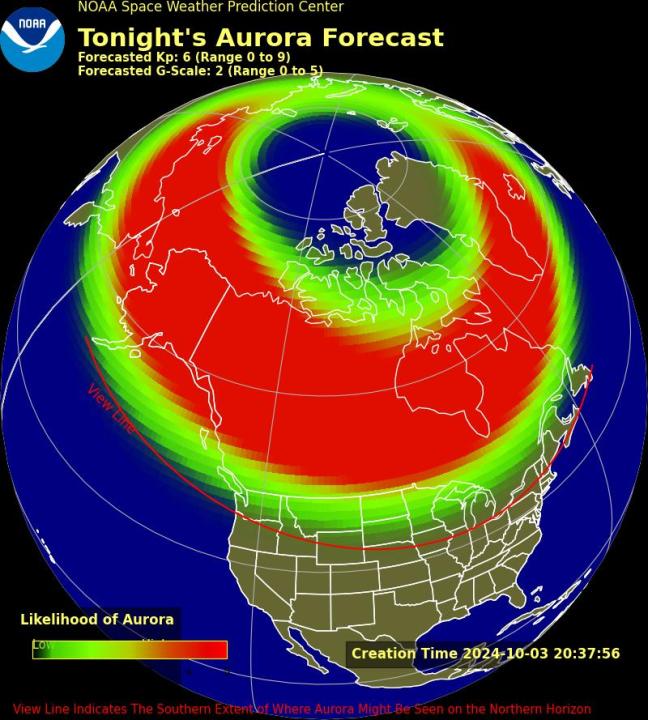Strongest solar flare since 2005 erupts: Will it impact Earth?
(NEXSTAR) — The largest solar flare recorded since 2017 erupted Thursday morning, marking the latest episode in an active period for the sun.
The eruption happened shortly after 8 a.m. ET, according to NOAA’s Space Weather Prediction Center. Flares like this can last “minutes to hours” and are classified based on their strength.
The scale ranges from B-class on the lowest end to C-class, then M-class, and finally, X-class. Each letter represents a ten-fold increase in energy output, and there is a scale of 1 to 9 in each class, except for X-class. X-class flares can exceed 9, with the largest-ever recorded being an X45 that occurred in 2003.
Thursday’s flare was much smaller, reaching only X9 strength. It was, however, the strongest this year, beating out an X7.1 flare that erupted earlier this week and an X8.7 flare in May (which Earth dodged). The latter was considered the strongest since 2005 — a feat seemingly bested by Thursday’s activity.
Solar flares are capable of impacting high-frequency communication bands and radio signals, as well as electrical grids and navigational systems. They are also often accompanied by coronal mass ejections (CMEs), which are explosions of plasma and magnetic material from the sun. Bill Murtagh, program coordinator for the SWPC and seasoned space weather forecaster, previously told Nexstar that CMEs are “essentially the Sun shooting a magnet out into space.”
Those CMEs can also bring the northern lights to our night skies. According to the SWPC, there are two CMEs sparked by Thursday’s solar flare that are anticipated to come our way over the next few days.
So what can we expect?
The SWPC has already issued a geomagnetic storm watch for the weekend. The watches are considered G3, or strong, on the five-point scale used to categorize a geomagnetic storm’s strength.
The agency says there may be “limited, minor effects to some technological infrastructure possible, but mainly mitigatable.” U.S. power grid operators are kept well-informed about the potential impacts of space weather, SWPC Service Coordinator Shawn Dahl previously told Nexstar. Those who rely on navigational systems, like pilots, are also well-equipped to weather geomagnetic storms.
Still, it is possible a strong geomagnetic storming could impact certain technologies, like satellites.
A strong, well-directed storm could also bring the northern lights to parts of the U.S. G3 storms have been known to bring the aurora as far south as Illinois and Oregon. Current SWPC forecasts for Thursday and Friday night show nearly identical likelihoods of where the northern lights will reach.
The maps below show those forecasts, with most of the northern U.S. having a low likelihood of seeing the aurora. They may, however, be visible along the northern horizon even further south along the red view line. States that, as of Thursday, have a chance at seeing the northern lights include Washington, Oregon, Idaho, Wyoming, Montana, North Dakota, South Dakota, Nebraska, Minnesota, Iowa, Wisconsin, Illinois, Michigan, New York, Vermont, New Hampshire, and Maine.


These forecasts could change over the next few hours and into Friday.
The SWPC predicts the strongest influences from the geomagnetic activity will come around 11 p.m. ET on Thursday and start again around 5 p.m. ET on Friday. These times prove favorable for aurora viewers in the U.S. — when activity peaks during daylight hours, we aren’t fortunate enough to see the celestial show happening above us (the view from space, however, can be intriguing).
If you don’t have a chance to see the northern lights this weekend, you’ll likely get another opportunity soon.
The sun is progressing through an active pattern known as Solar Cycle 25 in which it flips its poles. As we near the peak of that 11-year cycle, researchers say we can expect to see more strong solar storms — and, hopefully, more strong bouts of the northern lights.
Copyright 2024 Nexstar Media Inc. All rights reserved. This material may not be published, broadcast, rewritten, or redistributed..














